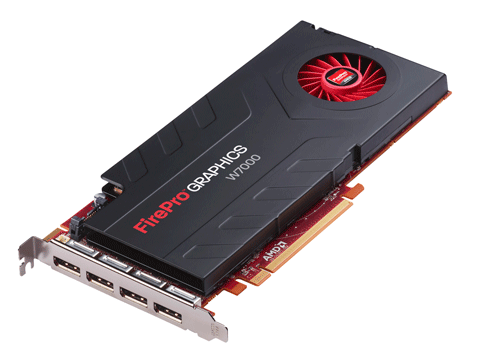
AMD FirePro W7000 graphics card – designed for high-end CAD
SIGGRAPH wouldn’t be SIGGRAPH without some major new professional graphics card technology and late last night – Los Angeles time – AMD took the lead on Nvidia by announcing a broad line up of new products.
And there was plenty to shout about. AMD unveiled four new discrete FirePro W Series graphics cards, based on AMD’s ‘Southern Islands’ 28nm GPU architecture – the FirePro W5000 (2GB), W7000 (4GB), W8000 (4GB) and W9000 (6GB). Also new from the chip manufacturer was an integrated CPU / GPU for low-cost entry-level workstations, the AMD FirePro A300.
Graphics Core Next (GCN) architecture
At the heart of the new FirePro cards is a brand new architecture which AMD calls Graphics Core Next (GCN). GCN delivers an expected boost in clock speed and stream processing units, but also a number of new features.
Firstly, it is designed to use GPU cores more efficiently. AMD explains how it is able to extract more performance out of a given number of processing units, adding that the GPU cores on its previous generation FirePro cards were often under-utilised.
A new power feature, AMD Powertune, increases clock speed to boost performance. It works by continuously monitoring how the GPU is utilised and, wherever possible, dynamically increases clock speeds, while keeping the card within its Thermal Design Power (TDP). This works on the principle that most real world applications don’t use all of the available power of a graphics card, something that is true in many CAD applications.
There’s also big news for those looking to use the GPU for compute, to accelerate simulation or rendering software. GCN is able to handle multiple threads on the same FirePro card at the same time. This could be up to two threads for GPU compute and one thread for traditional 3D graphics processing. This level of multi-tasking wasn’t supported on previous generation cards where the AMD FirePro GPU was either used for 3D graphics or for compute, but not both at the same time.
Running graphics and compute off the same GPU is a different approach to the one taken by AMD rival, Nvidia. Workstations that feature ‘Nvidia Maximus’ technology use a dedicated card for graphics (Nvidia Quadro) and a dedicated card for GPU compute (Nvidia Tesla).
That’s not to say AMD does not support multiple GPUs for GPU compute. In applications that are multi-GPU aware, AMD explained that more than one FirePro graphics card can be used together to boost performance.
Interestingly, there was no mention of a dedicated compute card to replace the old FireStream boards, so it looks like AMD will use FirePro to support both 3D graphics and compute in workstations.
AMD also made a lot of noise about OpenCL, and explained how the new FirePro cards are optimised for heterogeneous computing, being able to share data much more efficiently between CPUs and GPUs.
It showed off a big list of CAD/CAE and rendering applications that are currently ‘adopting OpenCL’. However, the reality is there are still relatively few mainstream OpenCL applications for design and engineering that are shipping. This should change soon though and when more OpenCL-enabled apps become commercially available, the prospect of running multiple threads on the same GPU could be an interesting proposition for those looking to do GPU compute on a budget. One of the downsides of Nvidia Maximus is that it needs a workstation with two dedicated GPUs, which pushes up costs.
Of course, AMD will need to demonstrate that a single FirePro card can handle multiple threads without impacting performance.
The FirePro W family
The new family of FirePro cards are based on AMD’s ‘Southern Islands’ 28nm GPU architecture and support PCI Express Gen3 for ultra-high 32GB/s transfer bandwidth.
The FirePro W5000 (2GB) and FirePro W7000 (4GB) are targeted at CAD users and will replace the FirePro V5900 (2GB) and FirePro V7900 (2GB).
The FirePro W5000 has three display outputs (2 x DisplayPort and 1 dual link DVI) and the FirePro W7000 has four (DisplayPort). However, both cards will be able to support up to six displays through the Multi Stream feature of DisplayPort 1.2 (daisy chained or via a Multi Stream Transport (MST) Hub).
Meanwhile, AMD’s dual slot cards, the FirePro W8000 (4GB ECC) and FirePro W9000 (6GB ECC) will replace the FirePro V8800 (2GB) and FirePro V9800 (4GB). These boards are targeted more at high-end CAD, visualisation and GPU compute (due to having a greater number of stream processors and large amounts of ECC memory).
The FirePro W8000 has four outputs (DisplayPort) and the FirePro W9000 has six (mini DisplayPort). The FirePro W8000 will also support up to six displays through DisplayPort 1.2.
Stereo 3D is available on all cards – natively on the FirePro W8000 and FirePro W9000 and via an optional bracket on the FirePro W5000 and FirePro W7000. Framelock/Genlock is offered on all but the FirePro W5000.
AMD has already announced some OEM wins with both HP and Dell having taken the FirePro W5000 and FirePro W7000 for their workstations. Dell will also offer the FirePro W8000 as a high-end option.
We’ll be testing the new high-end W8000 and W9000 with SolidWorks and PTC Creo soon so check back on DEVELOP3D.com.
Meanwhile, in the UK, AMD is offering some special deals on its FirePro V5900 and FirePro V7900 graphics cards. Details of the ‘cashback’ offer, which runs until September 30th 2012, can be found here.






